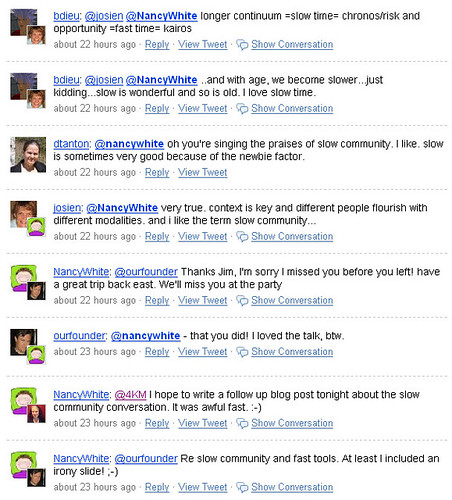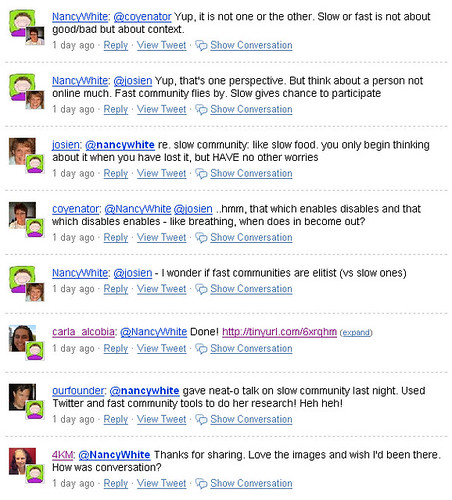 I promised earlier this week that I would post a follow up about my offering Tuesday night on Thinking about “Slow Community” (particularly online). Before it all (slowly) leaks out of my brain, here are some notes, comments and pointers to the ongoing Twitter conversation about “slow community.”
I promised earlier this week that I would post a follow up about my offering Tuesday night on Thinking about “Slow Community” (particularly online). Before it all (slowly) leaks out of my brain, here are some notes, comments and pointers to the ongoing Twitter conversation about “slow community.”
First, the host of the evening, Ryan Turner, wrote:
Nancy,
You ROCKED it last night. I knew you would. Thanks so much for making the time.
I think your talk pretty much blew everyone’s mind. It certainly got mine spinning, and I really think you’re on to something with the slow community idea. I too question whether it’s really slower or actually less–and I also wonder whether there’s a combination of those that ends up making sense. Do we partition our relationships? Our conversations (across relationships)? How do we manage work, where project groups form, dissolve, and re-form, but relationships (personal, intellectual, thematic) persist? Doesn’t seem to me anybody’s yet invented the social router, which could manage our cross-channel traffic in meaningful ways … though I do have some ideas … not to say a prototype ….
It was great to reconnect with you, just a bit, and I hope we can continue.
Best,
Ryan
Phew. And here I thought I was babbling and incoherent. 🙂 Thank goodness the other folks were all interesting. I enjoyed the offerings from Brian Fling of Flingmedia – Brian, did you talk about slow community at FOO Camp?; Justin Marshall of ZAAZ, Samantha Starmer from REI – Samantha, I have added “metadata strategy” to my online interaction checklist!; and Wendy Chisholm, who has opened my eyes to accessibility – even on a little old blog post – in a way that I needed. Thanks, Wendy!,
After the talks, I had the chance to have conversation with a few folks – unfortunately I did not write down names. I should have. Oi. Here are the points that came up that I can remember.
- If everything is so overwhelming and fragmented, what are the solutions? (The young guy who loved the chicken wings). I started to babble about a systems approach, but I need to actually understand better what that means. But I SENSE that this is important. True to my style, it usually takes me a while to figure out intellectually what I intuit.
- What is the role of information FLOW in creating a useful community experience, rather than overwhelm (the guy from Boeing).
- What is it we are really asking about – slowness, volume, simplicity?
- What should businesses be thinking about if they are in this crushing phase of “must have community?”
- What is the role of identity in all of this?
- And of course, Ryan’s “social router” which has MY head spinning.
On the Twitter front, besides the tweets already posted on the wiki, here is the latest round… thank you my TweetFriends. Oops, can’t do a screen capture. Since Windows did its last update, some of my old programs aren’t working. I was wondering when this was going to happen. Grrr. I’ll come back and edit it in. In the meantime, you can see them on Summize. I’ll go download Snagit and be right back!
(Later… here are the screen captures of the Tweets)



I really got a lot out of your talk, Nancy–it was excellent!
We have had a few solid years of various web pundits touting the virtues of popular online communities and “new” social practices. And, this is very aligned with the marketing of these popular services, in terms of how these services advertise their own virtues. But, I find that there’s a common, and too often unchallenged, assumption that this marketing / punditry shares:
That *more* connectivity and info sharing between people is both a good thing and the wave of the future, and that the real challenge is in making software / services that are better at helping people manage and filter their shared info, e.g., through social features like collaborative filtering, ratings / voting, tagging, etc., and also through software algorithms like page rank, Flickr’s “interestingness,” and Technorati’s “authority.”
In essence, this reflects a “quantity-oriented” approach towards connectivity and sharing. It’s about always looking for value through more participation–always value more “posts,” always value more “friends,” etc.
But, this assumption almost totally fails to imagine what a “quality-oriented” approach towards connectivity and sharing might look like, or how it might short-circuit the challenges of “too much information” and the “unwieldy social network(s).” A quality oriented approach will look very different, and will look to emphasize different features (social and algorithmic).
So, this made me think of “slow community” in these terms as well: quality-oriented community appears to be slower than quantity-oriented community. Quality-oriented community is only looking for value through meaningful (and, almost by definition, less) participation–only value real “posts,” only value real “friends.”
Jay, thanks for bringing up the “Q” words – quality and quantity. I suspect a healthy community finds its appropriate balance of quantity and quality. Quantity is often a source of diversity, so I’m not sure you want to ignore it. But quantity for quantities’ sake – not a winner!
As a birthright Quaker, I have a lot of experience with a very slow community.
In Quaker business meetings, making decisions can be a very slow process indeed. Even though it took years for them to reach untiy on the abolition of slavery, Quakers were among the first to oppose slavery.
This process of seeking unity leads to more enthusiasm and longer lasting support within the meeting community. This level of community commitment is particularly necessary when the issue is more fundamental. I believe that the Quaker practice of “standing aside,” similar to abstaining, should be reserved for less important issues.
This is such a powerful and important conversation … I love that it’s happening!
In the same way the Slow Food movement invites us to pay attention to the food we eat – where it comes from, how we are consuming it – and the Slow Living movement encourages us to live our lives mindfully and not spin out or try to turn ourselves into the machines we love to use, a call to “Slow Community” seems to be asking for a certain quality of attention in our online interactions, a mindfullness about what it is we are saying and a level of care for those with whom we’re speaking.
This has got to be good news!
Thanks, Nancy – your practical ear-to-the-ground and keen sense of cultural pattern recognition is always so valuable… I too have been thinking and even writing about these ideas for a while now, in my own extremely slow, under-the-radar kind of way. 🙂 So you can imagine how excited I was to find out about your work on this subject, especially given the capacity you have to bring it forward as a serious conversation in the field.
I’m joining this conversation a bit late but I trust the idea is still spinning around in all your minds and I had a reaction to this discussion so I thought I’d go ahead and respond. I’ve seen several blog posts this week that deal with this subject in one way or another so it seems to be getting some traction elsewhere too 🙂
I think one of the fundamental properties of online communities is that they expand the number of eligible community members. In 2000 I did content analysis of a NYC based email list for the rave subculture and this was the primary finding. People who didn’t necessarily fit the off-line requirements of being a raver (like frequently going to raves) could be active participants of the online community. This is also easily seen in Facebook etc where we re-friend and old contact and they persist now in our friend list – where they probably would have not have persisted in an off-line only life, even after a reconnecting moment. This week, Scott Brown at Wired posted a good article on some of the problems of friend collecting http://www.wired.com/techbiz/people/magazine/16-11/pl_brown
This, like most things, has advantages and disadvantages. There’s an potential increase in diversity (like expanding the notion of raver to fit ppl who didn’t go to raves) but also a potential for the dilution of the interaction between members (quick exchange with an old friend that’s not much more than trading stats; live here, work there, relationship status, kids y/n, happy). Not sure I have any suggestions for a balance between these but appreciate everyone asking these questions and spending brain cycles on this.
One of my pet-peeves is that I feel that there’s a certain schizophrenia added just by the number of locations and UIs we need to visit and interact with to maintain our online communities that adds to the speed at which we interact with any one community. If everything was accessible from one place and organized well do you think you might slow down and spend more time on the actual interactions? Like if you _only_ used Facebook?
I also think there’s something in here about synchronous versus asynchronous communication in the type of community interactions. With twitter being almost like a synchronous IM broadcast – you can see it in almost real time and it flows more like a conversation than any other medium. Not sure if anyone has thoughts on this – I don’t think it’s a simple correlation between delay and quality though.
Ok – that’s all I got for the moment, though I’m sure this is just the beginning of the cycle of this uber thought in my brain. 🙂